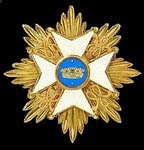I have been asked if it would be possible to have versions of the previous Charles VI company flags with white sheets to depict possible Leibfahnen so here they are:
Friday, 15 October 2021
Four of the Charles VI Austrian flags as possible Leibfahnen versions
Posted by
David Morfitt
at
Friday, October 15, 2021
8
comments
![]()
Wednesday, 13 October 2021
Flag of yet another unknown Austrian regiment of Charles VI, as probably carried in the 1740s by the army of Maria Theresa
And here's yet another Charles VI flag, after an illustration in my new source. I'd hate to have to paint those borders by hand on wargames flags; drawing them in a vector drawing program is tedious enough... But at least they do look good. I'll do another Prussian flag set next; it feels like a holiday doing them after the Austrian flags. 8-}
Posted by
David Morfitt
at
Wednesday, October 13, 2021
11
comments
![]()
Monday, 11 October 2021
Prague Prussian Flags Project - Flags of Prussian Infantry Regiment 31 von Lestwitz
Chef 1746-25th June 1763 Major General Johann Georg von Lestwitz, later Lieutenant General and Chef of IR 32
First raised 1729. In 1756 IR 31 was with Schwerin's 2nd Corps in Silesia. In 1757 the regiment was sent to Bohemia to join the King's army north-east of Prague on 6th May. Both the grenadiers and the musketeer battalions fought at Prague; they were part of the first line that was thrown back by the Austrian defence, the grenadiers losing nearly two-thirds of their numbers and the musketeers two-fifths. After the battle both were involved in the abortive siege of Prague. They missed the defeat at Kolin. In July they went to Silesia with the Duke of Bevern and were involved in the defeat at Breslau. After surrendering the city large numbers of the Prussian troops who marched out deserted.
In 1758 the regiment belonged to the Saxon Corps which advanced into Franconia. Hülsen then led them to join the Pomeranian Corps on the Warthe in June. At Kay (Paltzig) on July 23rd 1759 they were repulsed in the somewhat insane attack on the much stronger Russian position. The King took the regiment and grenadiers with his army to Kunersdorf on August 12th. The grenadiers, as part of the advance guard, lost over 50% casualties, and Frederick tried to use the musketeer battalions to help protect the retreating army after the lost battle on the Kuhgrund and the flight of the cavalry. They lost 431 men in the process (Duffy shows at least 40% losses). The King is said to have awarded every private soldier eight Groschen for their courage.
In 1760 IR 31 was at the unsuccessful siege of Dresden then at the battle of Liegnitz on August 15th. There only the grenadiers saw action and lost over 20% casualties. Two commanders received the Pour-le-merite for the action. On September 17th the regiment was involved in the storming of the heights at Hoch-Giersdorf, then at the battle of Torgau on November 3rd, serving in the Tettenborn Brigade of Zieten's command which decided the battle when Frederick thought it lost. They lost 200 men. The grenadiers were with Frederick's main army there.
Again with the King's army in 1761, the grenadiers were in the attack on the Adelsbach Heights on 4th July, losing 300 men, and then were involved in the successful siege of Schweidnitz from 8th August to October 10th. Unusually both grenadier and musketeer battalions almost always served together. The regiment was one of those in Frederick's favour after the Seven Years War.
And this was the uniform in 1756:
Posted by
David Morfitt
at
Monday, October 11, 2021
7
comments
![]()
Subscribe to:
Comments (Atom)





















